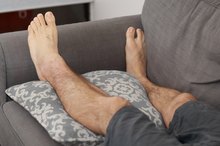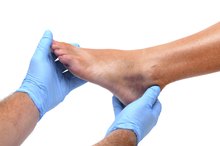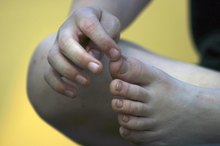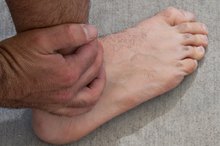How to Care for a Tattoo on Your Ankle
While tattoo care largely remains the same for any location of a tattoo on your body, some exceptions exist. Some swelling occurs as an after-effect of receiving a tattoo, and since an ankle tattoo is located on an extremity -- the leg -- swelling can prove more of an issue than in other areas of the body. In addition to general tattoo care, you should work to control the swelling as much as possible.
Remove the bandage from the ankle tattoo within approximately two hours after receiving the tattoo. The wound needs to breathe. Wash your hands thoroughly with warm water and soap before touching the ankle tattoo to avoid introducing bacteria to the wound.
How to Reduce Ankle Sprain Swelling
Learn More
Wash your ankle tattoo gently with warm water and soap, using your hands only 1. Do not use a washcloth or sponge to cleanse the tattoo. Pat the clean tattoo dry with paper towels. Do not use a cloth towel because it may harbor bacteria. Wash your tattoo two times per day, such as when you get up in the morning and before going to bed.
Cover the ankle tattoo with a thin layer of hydro-cortisone ointment to moisturize and help it heal. Repeat every time you wash the tattoo or if the tattoo becomes dry. After three to four days, switch to an unscented, uncolored moisturizing lotion.
How to Treat Swelling Nose Piercings
Learn More
Wear shoes that don't interfere with the ankle tattoo. It needs to remain untouched and open to the air. Do not wear any socks or jewelry or pants that may rub the tattoo.
Monitor your ankle tattoo for swelling. Elevate your leg atop a pillow and apply an ice pack -- plastic bag filled with ice and covered in a paper towel -- to the area for 15 minutes at a time throughout the day as you notice swelling. Sleep with your leg elevated at night to keep swelling at a minimum.
Tips
Gently cover your tattoo if you're going out in the sun. The sun can fade the colors.
Tape a piece of plastic wrap over your tattoo at night if you find that it's oozing. This can help protect your sheets.
Warnings
Sun block is helpful once the tattoo has healed, but don't apply it to a healing tattoo.
Related Articles
References
- Ancient Arts Tattoo Studio and Art Gallery: Tattoo Aftercare
- Lynn C, Michaela, Herdrich D, et al. The evolutionary adaptation of body art: Tattoo as an honest signal of enhanced immune response in American Samoa. Amer J Hum Biol. 2019:e23347. doi:10.1002/ajhb.23347
- Wilson WT, O’Boyle M, Leach WJ. Unusual complication of a tattoo in an immunosuppressed patient. Case Reports 2018; 2018:bcr-2018-224968. doi:10.1136/bcr-2018-224968
- Oanţă A, Irimie M. Tinea on a tattoo. Acta Dermatovenerol Croat. 2016;24(3):223-4.
- Tohme RA, Holmberg SD. Transmission of hepatitis C virus infection through tattooing and piercing: a critical review. Clin Infect Dis. 2012;54:1167–1178. doi:10.1093/cid/cir991
- Centers for Disease Control and Prevention. HIV transmission. Updated August 6, 2019.
- Warshaw EM, Schlarbaum JP, Taylor JS, et al. Allergic reactions to tattoos: Retrospective analysis of North American Contact Dermatitis Group data, 2001-2016. J Am Acad Dermatol. 2019;2:e61-e62. doi:10.1016/j.jaad.2019.09.077
- Kirby W, Alston DB, Chen AH. The incidence of hypertrophic scarring and keloid formation following laser tattoo removal with a quality-switched Nd:YAG laser. J Clin Aesthet Dermatol. 2016;9(5):43–47.
- Islam PS, Chang C, Selmi C, et al. Medical complications of tattoos: A comprehensive review. Clin Rev Allergy Immunol. 2016;50(2):273-86. doi:10.1007/s12016-016-8532-0
- Valbuena MC, Franco VE, Sánchez L, Jiménez HD. Sarcoidal granulomatous reaction due to tattoos: report of two cases. An Bras Dermatol. 2017;92(5 Suppl 1):138–141. doi:10.1590/abd1806-4841.20175860
- Orzan OA, Popa LG, Vexler ES, Olaru I, Voiculescu VM, Bumbăcea RS. Tattoo-induced psoriasis. J Med Life. 2014;7 Spec No. 2(Spec Iss 2):65–68.
- Ross JR, Matava MJ. Tattoo-induced skin "burn" during magnetic resonance imaging in a professional football player: a case report. Sports Health. 2011;3(5):431–434. doi:10.1177/1941738111411698
- Kaur RR, Kirby W, Maibach H. Cutaneous allergic reactions to tattoo ink. J Cosmet Dermatol. 2009;8:295-300. doi:10.1111/j.1473-2165.2009.00469.x
- Brady BG, Gold H, Leger EA, Leger MC. Self-reported adverse tattoo reactions: a New York City Central Park study. Contact Dermatitis. 2015 Aug;73:91-99. doi:10.1111/cod.12425
- Forbat E, Al-Niaimi F. Patterns of reactions to red pigment tattoo and treatment methods. Dermatol Ther (Heidelb). 2016;6(1):13–23. doi:10.1007/s13555-016-0104-y
- Rosenbaum BE, Milam EC, Seo L, Leger MC. Skin care in the tattoo parlor: A survey of tattoo artists in New York City. Dermatology. 2016;232:484-489. doi:10.1159/000446345
- Khunger N, Molpariya A, Khunger A. Complications of tattoos and tattoo removal: Stop and think before you ink. J Cutan Aesthet Surg. 2015;8:30–36. doi:10.4103/0974-2077.155072
- United States Food and Drug Administration. Tattoos & permanent makeup; fact sheet. Oct 31, 2019.
Tips
- Gently cover your tattoo if you're going out in the sun. The sun can fade the colors.
- Tape a piece of plastic wrap over your tattoo at night if you find that it's oozing. This can help protect your sheets.
Warnings
- Sun block is helpful once the tattoo has healed, but don't apply it to a healing tattoo.
Writer Bio
Based in Texas, Cynthia Measom has been writing various parenting, business and finance and education articles since 2011. Her articles have appeared on websites such as The Bump and Motley Fool. Measom received a Bachelor of Arts in English from the University of Texas at Austin.









